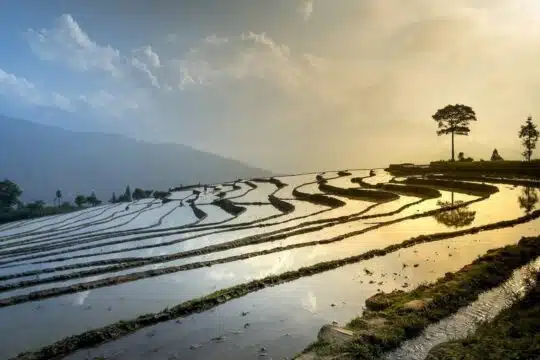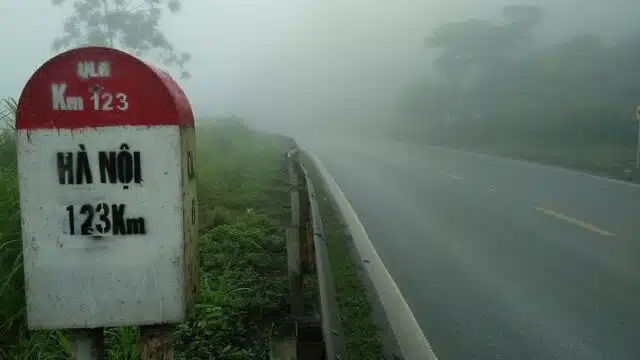Vietnam is a gorgeous country bristling with new and interesting experiences. A visit to this culturally and geographically diverse Southeast Asian nation is one you won’t soon forget. The best time to go to Vietnam can be any time of the year, depending on which activities interest you.
Some of the most compelling aspects of Vietnam are its landscapes, temples, people, and history. Step foot in Vietnam and you’ll soon find yourself falling in love with the country, and of course with Vietnamese food, too!
Below we’ll discuss the best time to visit Vietnam by covering its climate and weather, public festivals, and holidays. There are some surprises here – for example, when I first arrived in Vietnam, I was surprised at how cold it gets in the north of the country. Keep this in mind when booking your Halong Bay cruise!
Once you figure out the most suitable time for your visit, then you can start planning what to wear and what to pack for your Vietnam holiday!
CLIMATE AND WEATHER IN VIETNAM

Vietnam is typically characterized by sticky jungles and hot beaches, but its condition is absolutely varied. There are very low temperatures and even snow in the “North” area. There are 2 monsoon seasons in Vietnam. The first is southwest monsoon that starts from April and ends in September. The second is northeast monsoon that starts from October and ends in March/April.
The monsoon is associated with rain normally, but that is not a whole case in Vietnam. The number of regional changes influences the rain. Actually, the southwest monsoon is hot, foggy and moist weather but the northeast monsoon is drizzling and colder to the north and dry to the south.
By the way, this country can be divided into three areas which posses very different climate from each; the north, the centre and the south. It is significant and must be high on your checklist to see the climate for these parts to know the best time to travel to Vietnam.
RELATED POST: Affordable motorbike tours in Vietnam

WHEN IS THE SUMMER IN VIETNAM
The north down to central Vietnam is safe to say that has weather and climate that is more like a Northern Hemisphere routine (spring, summer, autumn, winter). The central to the south of Vietnam is more like a summer feeling all year round apart from the typhoon season. The summer starts in mid of June and ends on the mid of September.
In Summer, the average temperature across the country is 25 degrees Celsius (77F). Vietnam is very hot in summer, temperatures can reach 37 degrees Celsius (98F), rain can appear suddenly in the afternoon, lasting about 1-2 hours.
However, in late Summer, the temperature is cool and more preferred. So, Summer is the ideal time of year for travellers and tourists to discover and experience the country.
RELATED POST: How to extend your Vietnam visa & Best hiking spots in Vietnam
WHEN IS THE WINTER IN VIETNAM
The winter in Vietnam starts from the mid of December and ends in the mid of March. Two places “Hanoi” and “North Vietnam” continue with a long moist winter occasionally dropped below 10 degrees Celsius (50F) or even to the point of freezing and light snow especially in the mountains like Sapa. The “Central” and “South” is hot and dry.
This beautiful country offers great sights and sounds that everybody ought to visit a minimum of once. Anyhow, travellers wanting to travel this country in winter by selecting its correct destinations as the temperature differs from north to south.
The “Central” and the “South” get daylight more, which offer tourists the right Vietnam beach vacation with gentle temperatures (minimum of 23 degrees Celsius (73F) and a maximum of 26 degrees Celsius (79F)). But the “North” has a moist coldness.
Hanoi and other nearby areas can even drop to below 10 degrees. There are some mountainous areas like Sapa, Ha Giang and Mau Son where the temperature can even drop below 0 degrees Celsius (32F). Tourism is treated to be in high season as many foreign travellers come to explore this area during this time disregarding the coolness of the north area in winter.
RELATED POST: How to get around Vietnam: Transportation in Vietnam
WHEN IS THE RAINY/TYPHOON IN VIETNAM
In “South”, the rainy season starts from April to September/October. In this season, June, July, and August are considered the rainiest. That means 11 inches of rain a month on average.
The “North” is cool and dry from November to April, whereas it is hot and rainy from May to October. The huge distinction between the “North” and the “South” is the temperature that changes more in the “North” and actually gets cold from December to February.
Taking the season out of the table, when there are typhoons and tropical depressions from the East can result in frightfully heavy rain and strong wind all week which can affect and ruin your travel plans. Worse, they can cause flooding, power outage, and other massive interruption not only for tourists but mostly for the locals.
Even these things happen, in general, around December every year, you should expect that typhoon season is over, however, it still depends on which part of Vietnam we are talking about. Either way, remember that June to August is the most story months of the year all over Vietnam.
If you planning to go motorbiking in Vietnam, checking the typhoon prone months is very essential especially for safety reasons.
ALSO READ: Different seasons in Hanoi

PUBLIC FESTIVALS AND HOLIDAYS IN VIETNAM
There are a lot of holidays and festivals in Vietnam, national and influenced by fashion. Celebrating these holidays and festivals in Vietnam continues for a week or more, even it can last two weeks. Holiday’s dates can be changed every year according to the Lunar Calendar.
There are festivals and holidays name mentioned:
- Chinese Lunar Calendar (January 1st-3rd)
- New Year (The 1st of January) – business as usual
- Tet Festival (Lunar New Year: Late Jan to mid-Feb) – everything will be closed apart from tourism industry businesses
- The Hung Kings’ Temple Festival (From 8th to 11th day of the 3rd Lunar Month)
- The Liberation of Saigon (the 30th of April)
- International Workers’ Day (The 1st of May)
- National Day (The 2nd of September)
- Teachers’ Day (The 20th of November)
- Vietnamese Traditional Festivals
- Perfume Pagoda Festival (Huong Pagoda Festival)
- Bai Dinh Temple Festival (6th day of Lunar Month)
- Lim Festival (12th, 13th days of first Lunar Month)
- Mua Vu Lan, or Mother’s Day
- Hungry Ghost Festival (15th day of 7th Lunar Month)
- Mid-Autumn Festival
RELATED POST: International hospitals and medical clinics all over Vietnam

WHEN IS THE BEST TIME TO GO TO VIETNAM
To say it simply, the first thing you need to do is to decide which part of Vietnam you are heading to. In the North, it’s best to come from August to November, December to January is cold, misty, and very slippery in the mountains. In the central of Vietnam, it’s best to come from December to July while in the South, from August to December are the best time of the year.
Two of the most important things to remember is to check the climate of the part of Vietnam you are going to and to make sure that it will not be a long-week public holiday like Tet (Lunar New Year) to avoid any hassle or worse, an impossible trip to enjoy.
With such complicated weather seasons, there is no one particular season to endorsed as the best time to enter Vietnam. By the way, the autumn season (from September to December) and the spring season (from March to April) are presumably the best seasons if you want to cover entire Vietnam.
Tips for Trip Success
Book Your Flight
Find an inexpensive flight by using Kayak, a favorite of ours because it regularly returns less expensive flight options from a variety of airlines.
Book Your Hotel or Special Accommodation
We are big fans of Booking.com. We like their review system and photos. If we want to see more reviews and additional booking options, we go to Expedia.
You Need Travel Insurance!
Good travel insurance means having total peace of mind. Travel insurance protects you when your medical insurance often will not and better than what you get from your credit card. It will provide comprehensive coverage should you need medical treatment or return to the United States, compensation for trip interruption, baggage loss, and other situations.Find the Perfect Insurance Plan for Your Trip
